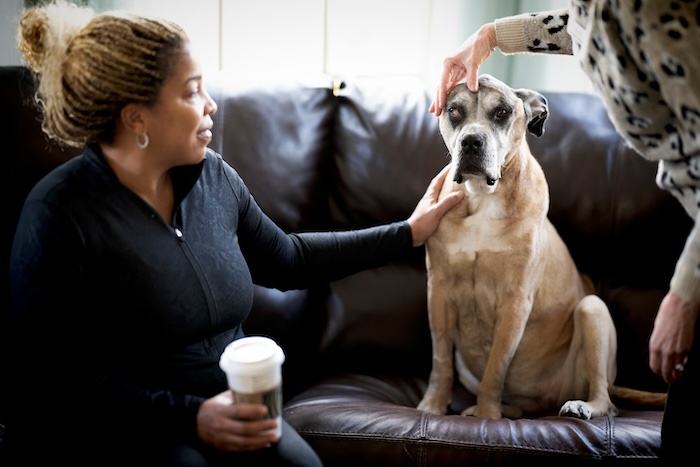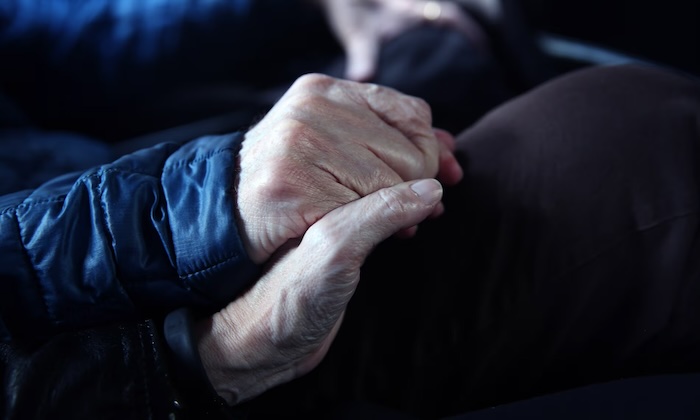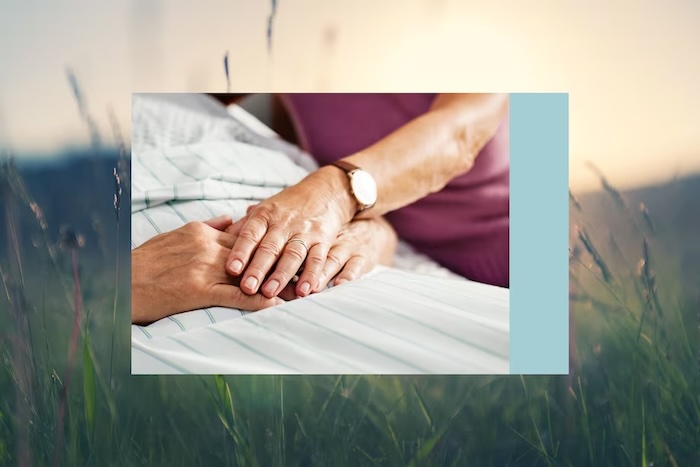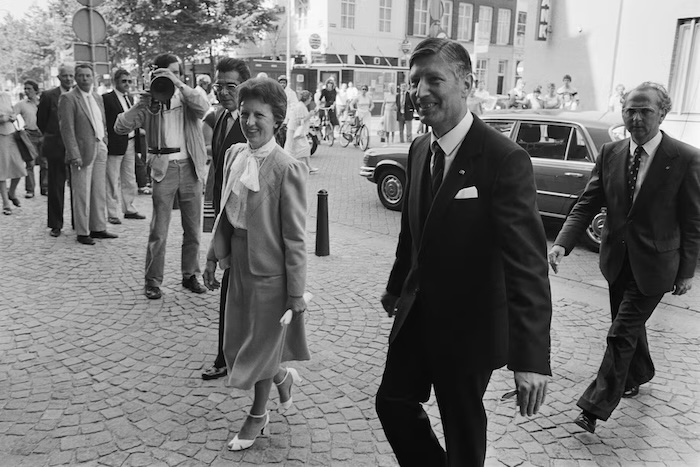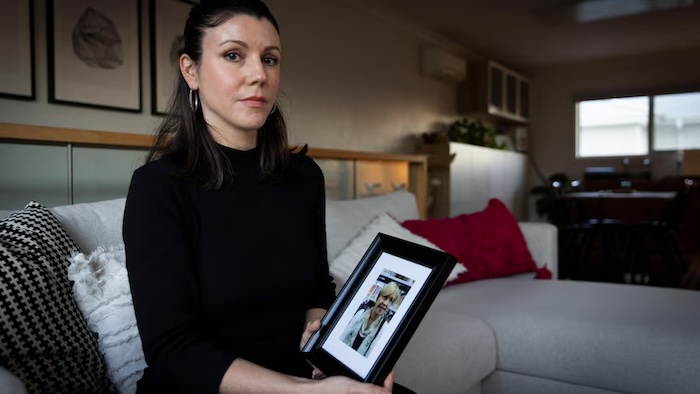
By Annika Blau
It’s July 2021, and Miki is begging for help.
Her mum is trying to ask her doctor something, but in recent weeks, she’s lost the ability to speak.
Miki’s mum has motor neurone disease (MND) and her only means of communicating is with a letter board, where she blinks to spell out what she’s trying to say.
She needs staff from her hospital to operate the equipment, but they’re refusing to be involved.
“It really sent a … message that what we were doing was wrong,” Miki says.
Eventually, Miki’s begging reaches the hospital CEO, who grants special permission for an occupational therapist to set up the letter board.
“There were rules that [the occupational therapist] could set my mum up with the equipment, but they were not to be present in the room for any conversations,” Miki says.
And then, letter by letter, Miki’s mum blinks to spell out her request: She wants to die.
Voluntary assisted dying (VAD) has been legal in Victoria since 2019, meaning people like Miki’s mum who are suffering from a degenerative condition can choose to take certain medication to end their life.
But healthcare providers can refuse to facilitate VAD if they object to it on ethical grounds.
This is the situation Miki and her mother found themselves in.
“I was really shocked to learn that a publicly funded hospital could have policies that existed on ideological or religious grounds,” Miki says.
“Someone like my mum, who can’t talk, can’t move, can’t advocate for themselves… is facing just about as many barriers as a person can face. So every little hurdle that’s added to that is just an enormous stress to overcome.”
‘Forbidden to raise the topic’
At her home in the west of Melbourne, Miki stops in the hallway and gazes into a bedroom.
It’s stacked floor to ceiling with boxes — her mum’s entire life — but Miki can’t bear to face it just yet.
Her mum was a dance teacher and later a librarian, but when she started having falls in 2019, she was diagnosed with MND.
Miki’s mum was living in South Australia at the time, but they were told one of the best places to get care for MND was in Melbourne, at Calvary Bethlehem Hospital.
“We also knew she’d be able to access VAD in Victoria, which she couldn’t in South Australia, so we moved her over,” Miki says.
What they didn’t realise was that Calvary Bethlehem is one of 21 public Catholic hospitals around Australia with a blanket policy against VAD.
Miki noticed right from the first appointment “an undercurrent of nervousness in everyone we spoke to at Calvary Bethlehem — if you mentioned VAD, it was like hitting a brick wall.”
But they didn’t know where else to turn. To Miki, switching hospitals felt like choosing between the best possible care, and the best possible death.
“As we understood it, Calvary Bethlehem was the place that people with MND go. It was never discussed with us that there was an alternative that might be better able to support my mum’s desire to apply for VAD,” Miki says.
One doctor, speaking on the condition of anonymity, told Background Briefing that referring doctors can’t warn their patients about Calvary Bethlehem’s stance, because raising VAD with a patient is illegal.
Doctors can only answer questions about VAD if the patient raises it first, and many have not yet considered it when they’re first diagnosed and choosing a hospital.
“Patients who are inadvertently admitted to Catholic hospitals may never learn of their rights and as doctors we are not allowed to educate them — the questions must come from them,” the doctor said.
“I am forbidden by law to raise the topic. Therein lies a massive problem.”
The doctor said they’d had to remove patients from Calvary Bethlehem’s “superb service” due to its refusal to be involved in VAD.
In a statement, Calvary Bethlehem confirmed the team caring for Miki’s mother were following its policy of not being involved with VAD.
It said it responds “openly, sensitively and respectfully to anyone expressing a wish to explore VAD” and “would not block a person’s access”.
Personal views influencing policy
Objection to VAD is also prevalent in the palliative care sector, where Catholic-run organisations are major players.
But objection is not limited to faith-based organisations — many secular public facilities also refuse to be involved.
QUT Professor of end of life law and regulation, Ben White, says the policy for entire institutions is often influenced by the views of individuals in leadership positions.
Professor White interviewed dozens of families in Victoria about accessing VAD.
He says the majority described objection by healthcare facilities, with their loved ones blocked from having VAD doctors or pharmacists visit, or prohibited from taking the medication on site.
Objection was particularly problematic for regional families he interviewed, who “didn’t have the ability to just go to the next institution down the road,” he says.
‘He scolded me’
Like Miki, Julius Pieker had to watch his mother decline during the pandemic.
She had ovarian cancer, and after a bad fall, was sent to Wantirna Palliative Care Unit — a secular public facility servicing Melbourne’s eastern suburbs.
During her stay, she summoned Julius to her bedside and told him she wanted to use VAD. Under the legislation, this is available to anyone expected to die within six months.
“I said to her, look, we’ll support you in whatever you want to do,” he says.
Julius looked around the facility for someone to tell, and spied his mother’s doctor.
But the doctor’s reaction floored Julius.
“He scolded me. And tried to say that I was not to encourage my mum to do this,” Julius says.
“I was distressed by him making that sort of accusation that I would do that, and I told him so.”
Julius says the doctor was silent.
“He didn’t try to console me or say, you know, ‘I didn’t mean to give you the wrong impression’. He was just like stone,” he says.
Legally, there’s no obligation for objecting doctors to refer people like Julius on to a service that might be able to provide more information.
“I was left feeling that I had nowhere to go after I spoke to that one person,” Julius says.
What Julius didn’t realise was that until recently, Wantirna had been transferring patients who requested VAD out of this public facility.
“I didn’t know about the politics of palliative care,” Julius says.
“They have no right to stop people from accessing [VAD], because it’s legal.”
Julius’s mum was transferred back to the public hospital she’d initially come from, where she was able to access the VAD medication to end her life.
Melbourne oncologist, Prasad Cooray, says the transferring of patients out of Wantirna has been an “ongoing problem” for him and his colleagues.
In some instances, patients have been transferred upon requesting a VAD permit — before they even decide whether to go ahead with using the medication.
“[Transferring patients] takes away dignity and adds unnecessary distress to these last moments of their lives,” Dr Cooray says.
His biggest fear has been that one of his patients could die in the back of an ambulance during a transfer — “a dying patient is dying, unstable,” he says.
Patients can also be distraught on having to move facilities, and feel chastised, he says.
“It’s a judgement that’s passed upon you. How terrible is that — that we are passing a judgement on the dying patient in a place where we need to be infusing humanity and love?”
The other public palliative care centre in Dr Cooray’s catchment is Caritas Christi, a Catholic organisation with limitations around VAD.
The main option left for patients wanting VAD has been the acute medical wards of local hospitals, which Dr Cooray says are “one step down from an emergency department” and “not designed for dying”.
“Palliative care places are … a much more peaceful environment, as homely as you can make it,” Dr Cooray says.
“These institutions exist for the benefit and for serving the patients.
“And I do not understand how it’s been flipped around that it exists to serve the conscientious objections of staff. Those people should … step aside and allow people who do not have objections to carry it out in that place.”
In other instances, patients had been transferred home, where families often felt ill-equipped to provide 24/7 care for their dying loved one.
Dr Cooray said the local health authority, Eastern Health, had been long aware of the situation at its Wantirna Palliative Care Unit.
But last year, Victoria’s VAD Board got involved after a complaint from a patient’s family.
Eastern Health then changed its guidelines to mandate that VAD be accessible at all its sites, and in recent months, Wantirna stopped transferring patients seeking VAD.
Complete Article ↪HERE↩!



